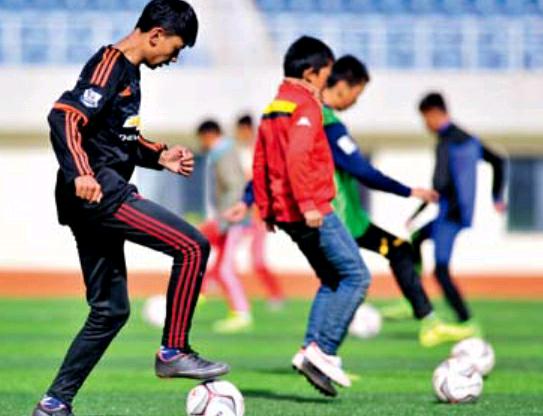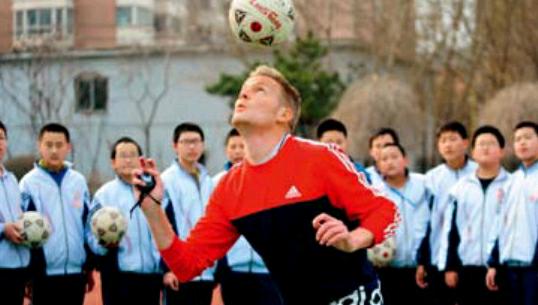Chinese Football’s Future Stars
2016-07-25byGongHaiying
by+Gong+Haiying
From April 30 to May 7, 2016, matches between U15, U14, and U13 rivals of the Chinese National Youth Football League were played. Including kids from U12 teams about to participate in the National Youth Football Summer Camp, which was first launched by Chinas Ministry of Education in 2009, participation totaled nearly 3,000 players in 106 teams.
These young Chinese players are carefully selected to join the countrys “competitive professional football population,” after undergoing bone age assessment in accordance with the requirements of Chinese Football Association. This population doesnt include players in professional football schools.
By the end of 2015, the number of football specialty schools at both national and local levels totaled 16,186. In just one year, the National Leading Group Office for Youth School Football trained more than 2,000 directors of educational administrations at prefecture, city, and county levels, more than 3,000 headmasters of elementary and middle schools, 5,400 elementary and middle school P.E. teachers, and 1,000 coaches, referees, and retired athletes.
Statistics show not only that China is witnessing a significant rise in professional youth football training, but also that great changes are happening around the countrys school football development.
Quantitative Changes
Once the dominant power in Asia, Chinese football began its professionalization process in the 1990s. Although the sport enjoyed renewed vigor brought by that reform, it soon crashed and another high-level national or professional team never emerged. The major reason for this phenomenon is Chinas lack of football professionals.
In 2008, China began developing football in schools. Chinas General Administration of Sport and Ministry of Education formulated a ten-year plan for youth football development in schools, and set up the National Leading Group Office for Youth School Football. Soon, local offices to promote youth football in schools were established across China.
On March 16, 2015, the Chinese government issued Overall Plan for Chinese Football Reform and Development. According to the plan, Chinas Ministry of Education would oversee football development across the country, combining the aims of sports development with talent cultivation. This act marked the elevation of school football development to a national strategy. On April 11, 2016, the Medium and Long-Term Development Plan for Chinese Football (2016-2050) was announced by the Chinese government, in which goals for school football development were made even clearer: By 2020, the country should have 20,000 schools specializing in football, 70,000-plus pitches, and 30 million elementary and middle school students regularly playing the sport among more than 50 million Chinese people active in the game.
With strong governmental support, quantitative change is taking place in Chinas school football. Four competitive leagues at different levels are now available to Chinese schools. The top amateur league, the China University Football League, has received a historic influx of participation, with 529 participating teams quickly jumping to 800 and quantity of matches soaring to more than 1,500 during its 2015-2016 season. On the younger side, leagues for elementary and middle school students in Shenzhen, Guangzhou, and Shanghai are expanding.
Alongside more extensive football activity in schools, training of elite youth football players has also been enhanced. At the end of 2015, the General Administration of Sport set up national-level youth football training centers in five Chinese pilot football cities: Chengdu, Qingdao, Wuhan, Guangzhou, and Dalian. Also, various youth training centers have been set up in 20 cities and 38 counties, which are all free to the general public. “Youth training centers can benefit local kids by providing them professional football training,” remarked Wei Jixiang, vice president of Chinese Football Association. “Our aim is not only to cultivate first-class players, but also to expand interest in football and nurture the sports social atmosphere, which we should have done long ago,”remarked Wei.
There is little doubt that Chinas school football and youth training centers, which are undergoing quantitative changes, will become the driving force for the countrys future football development.
Changed by Football
Senior football commentator Xiao Liangzhi pointed out that according to the Overall Plan for Chinese Football Reform and Development, the countrys reform of school football provides young players with more opportunities, which will certainly encourage more Chinese kids to play.
According to the overall plan, China will explore and establish football schools in certain universities and colleges—a new type of football school combining academics and the sport. According to data from Chinas Ministry of Education, by the end of 2015, the country had identified 8,627 schools as specializing in football. For a long time, Chinese parents worried that because only a very small proportion of players can ultimately play professionally, the vast majority of football students will be left with little opportunity. The establishment of football schools in colleges will help solve the problem. For players who fail to be admitted to professional teams or regular universities after turning 18, their special skills in football may allow them the opportunity to enter a universitys football school.
To better develop school football and get more teenagers involved and passionate about the game, priority should still be placed on changing current ideas about football education.
Wang Dengfeng, vice president of the Chinese Football Association, added that in the next round of Chinas curriculum reform, schools will be encouraged to teach students one or two specific sports in P.E. class such as football, basketball, and volleyball, with the aim of promoting sports skills and improving physiques.“In terms of developing school football versus other sports, our fundamental aims are the same,” he opined. “We want to show that education and sports go hand-in-hand.”
Today, China places more attention on the combination of football training and academics when encouraging football devel- opment in schools. Increasing numbers of football school headmasters are attaching equal importance to both football training and academic learning, and more Chinese parents support their children participating in the game. Moving beyond dreams of seeing kids become football stars, headmasters and parents want children to receive a special brand of education flavored by football, which will no doubt lead to healthy development of the game in China.